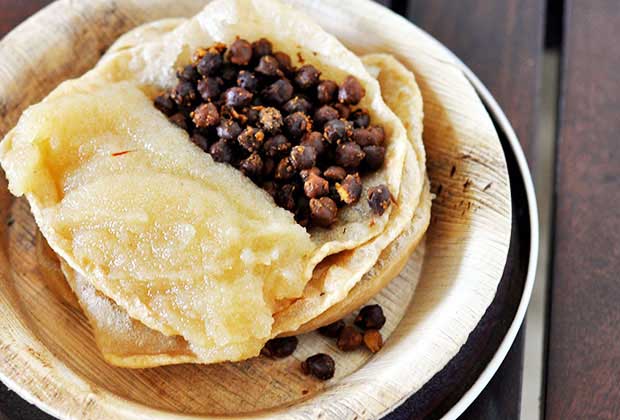Navratri In The Time Of Halwa Aur Poori Chole
- By Monika ManchandaLoading...
- | 17 Oct 2015 10:00 AM IST
 X
X
 Halwa and poori chole are popular treats on Navratri in north India. Photo: Monika Manchanda
Halwa and poori chole are popular treats on Navratri in north India. Photo: Monika Manchanda
I grew up in Delhi of the olden times, in small bylanes of a lesser-known part of town. We used to live in a mohalla where everyone knew everyone else, where bonds were fostered over food and festivals, and over celebration and sharing. Every year the arrival of Navratri would mark the beginning of a season of joy, festivities and sweets galore. Not to forget the interesting home-made treats, which were also shared with friends and family.
The nine days of Navratri in my part of the country are marked by the pooja of Devi and fasting for nine days. One would refrain from partaking any grain and eat only satvik foods for those few days. The houses would be stocked with sabudana to be made into sabudana khichdi in the morning or for frying crisp sabudana vadas to go with the evening chai. There would be gluten-free flours like kuttu, swang, rajgira and more, which would be bought to make pakoras, parathas and khichdi. Those nine days would be a treat to the soul and a way to detox too.
The story goes that Durga was hiding from Bhairav in a cave up in Vaishno Devi. She didn’t have food, and after winning over Bhairav, she walked to a small village and was offered halwa, chole and poori to eat. People now fast by remembering the story and feed little girls the same food on kanya pooja where they represent the Devi themselves.
I might have problems with the concept of kanya pooja now, but while growing up it was a festival I loved. We would deck up in new clothes, get together with friends and then go from house to house collecting the poori and chole apart from little goodies that came along. While some would give money, others would give a little knick-knack. At the end of the day, we would sit together and discuss about the aunty who made better halwa and whose poori was the crispiest. Then we would plan what to buy with that little money we collected.
I don’t do kanya pooja anymore, but every year I recreate the magic of those days with halwa-poori and chole in the kitchen for breakfast for the sake of nostalgia and more.
Recipe for Sooji Halwa
1/2 cup ghee
1 cup sooji (semolina, fine chiroti rawa)
1 tsp besan (gram flour)
2 cups sugar
4 cups water
1/4 cup raisins
1/4 cashew or any other nuts you want
Pinch of salt
Method
1. In a big bowl, heat sugar and water together till completely dissolved; the best is to make 'one string sugar syrup', but it works without that also.
2. In a heavy bottom pan, heat ghee and add sooji and roast it by constantly stirring. When it starts to change colour, add besan and roast till the sooji is aromatic and light brown in colour.
3. At this stage, add the hot sugar syrup. Be careful while doing so as the batter will sizzle. Don't burn yourself.
4. Cook till the water dries a bit and the halwa starts to leave ghee on the sides.
5. Heat one more tablespoon of ghee and roast the nuts and raisins. Add to the halwa and serve hot.
Recipe for Dried Black Chana
Ingredients
2 tbsp ghee
1 cup black chana
1 tsp jeera seeds
2 tsp chole masala
1 tsp coriander powder
1/2 tsp chilli powder
Method
1. Wash and soak the black chana overnight. Next morning, drain and boil it in a pressure cooker with three cups of water for 10 to 12 minutes on low heat after the first whistle.
2. Once cool, drain all over and store for later use. You can use this in dal or attas as this is extremely nutritious.
3. Heat the ghee in a kadhai and add the jeera seeds to it. Once they turn brown, add all dry spices and roast for 1 minute on low heat.
4. Add the boiled chana and slightly mash some of it. Roast for 8 to 10 mins.
5. Serve chole and halwa with crisp freshly-fried pooris and be transported to the bygone era.
Monika's food blog Sin-A-Mon Tales comprises reviews, recipes and food stories from her travels and childhood. She also writes for many websites and publications. An avid reader and an obsessive traveller, Monika is always looking for food history and culture.



